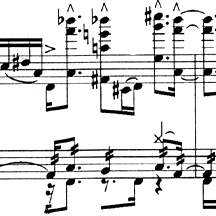|
|
||||||||||||
|
|
|
|
|
|
|
|
|
|
|
|
|
|

=back
Louis Andriessen, WORKERS UNION (1975)
Workers Union is a "symphonic movement for any loud sounding group of instruments." Pitches are not traditionally notated, but are spaced relative to a single horizontal line, which represents the center of the instrument's register. Much in the same aesthetic as other works of his same period, such as Hoketus, the composer requests that it "sound dissonant, chromatic and often aggressive." Andriessen states that "only in the case that every player plays with such an intention that his part is an essential one, the work will succeed; just as in the political work." Workers Union is usually played with six or more people, Yesaroun' performs it with just two - Eric plays multiphonics on baritone saxophone and Sam plays amplified piano with his left hand and a pile of gongs with his right.
Louis Andriessen was born in Utrecht in 1939 into a musical family: his father Hendrik, and his brother Juriaan were established composers in their own right. Andriessen studied with his father and Kees van Baaren at the Hague Conservatory, and between 1962 and 1964 undertook further studies in Milan and Berlin with Luciano Berio. Since 1974 he has combined teaching with his work as a composer and pianist. He is now widely regarded as the leading composer working in the Netherlands today and is a central figure in the international new music scene. From a background of jazz and avant-garde composition, Andriessen has evolved a style employing elemental harmonic, melodic and rhythmic materials, heard in totally distinctive instrumentation. His acknowledged admiration for Stravinsky is illustrated by a parallel vigour, clarity of expression, and acute ear for colour. The range of Andriessen's inspiration is wide, from the music of Charles Ives in Anachronie I, the art of Mondriaan in De Stijl, and medieval poetic visions in Hadewijch, to writings on shipbuilding and atomic theory in De Materie Part I. He has tackled complex creative issues, exploring the relation between music and politics in De Staat, the nature of time and velocity in De Tijd and De Snelheid, and questions of mortality in Trilogy of the Last Day.
=back
| © Yesaroun' Duo |